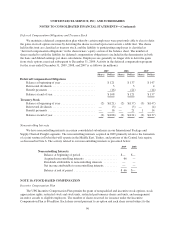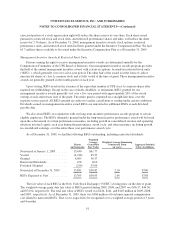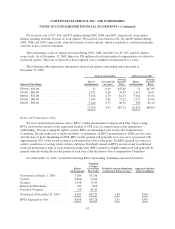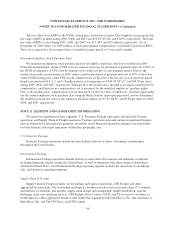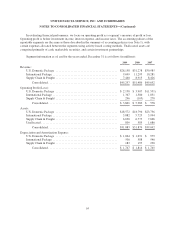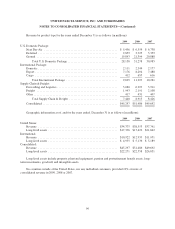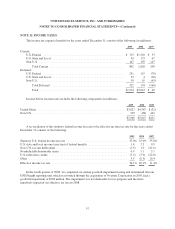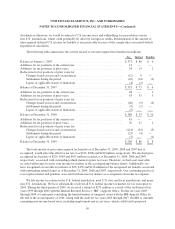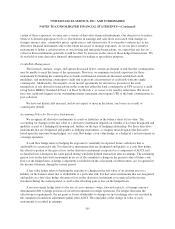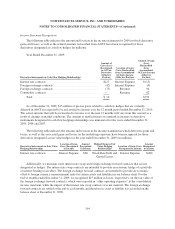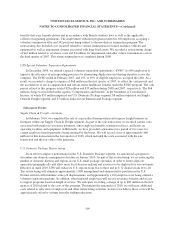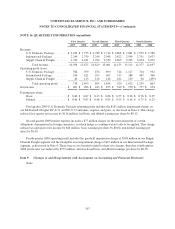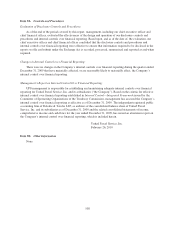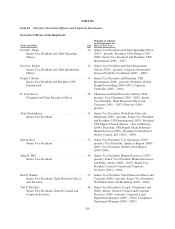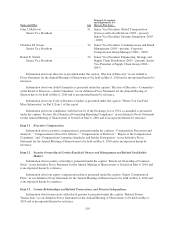UPS 2009 Annual Report Download - page 112
Download and view the complete annual report
Please find page 112 of the 2009 UPS annual report below. You can navigate through the pages in the report by either clicking on the pages listed below, or by using the keyword search tool below to find specific information within the annual report.
UNITED PARCEL SERVICE, INC. AND SUBSIDIARIES
NOTES TO CONSOLIDATED FINANCIAL STATEMENTS—(Continued)
assessments. The IRS has not presented an official position with regard to these taxes at this time, and therefore
we are not able to determine the technical merit of any potential assessment. We anticipate receipt of the IRS
reports on these matters by the end of the second quarter of 2010. We have filed all required U.S. state and local
returns reporting the result of the resolution of the U.S. federal income tax audit of the tax years 1999 through
2002. A limited number of U.S. state and local matters are the subject of ongoing audits, administrative appeals
or litigation.
A number of years may elapse before an uncertain tax position is audited and ultimately settled. It is
difficult to predict the ultimate outcome or the timing of resolution for uncertain tax positions. It is reasonably
possible that the amount of unrecognized tax benefits could significantly increase or decrease within the next
twelve months. Items that may cause changes to unrecognized tax benefits include the timing of interest
deductions and the allocation of income and expense between tax jurisdictions. These changes could result from
the settlement of ongoing litigation, the completion of ongoing examinations, the expiration of the statute of
limitations, or other unforeseen circumstances. At this time, an estimate of the range of the reasonably possible
change cannot be made.
NOTE 13. EARNINGS PER SHARE
The following table sets forth the computation of basic and diluted earnings per share (in millions except per
share amounts):
2009 2008 2007
Numerator:
Net income attributable to common shareowners ......................... $2,152 $3,003 $ 382
Denominator:
Weighted average shares ............................................ 995 1,014 1,055
Deferred compensation obligations ....................................222
Vested portion of restricted shares ..................................... 1 — —
Denominator for basic earnings per share ................................... 998 1,016 1,057
Effect of dilutive securities:
Restricted performance units .........................................222
Restricted stock units ...............................................432
Stock options ..................................................... — 1 2
Denominator for diluted earnings per share .................................. 1,004 1,022 1,063
Basic earnings per share ................................................. $ 2.16 $ 2.96 $ 0.36
Diluted earnings per share ............................................... $ 2.14 $ 2.94 $ 0.36
Diluted earnings per share for the years ended December 31, 2009, 2008, and 2007 exclude the effect of
17.4, 11.7, and 8.9 million shares, respectively, of common stock that may be issued upon the exercise of
employee stock options because such effect would be antidilutive.
NOTE 14. DERIVATIVE INSTRUMENTS AND RISK MANAGEMENT
Risk Management Policies
We are exposed to market risk, primarily related to foreign exchange rates, commodity prices, equity prices,
and interest rates. These exposures are actively monitored by management. To manage the volatility relating to
100


